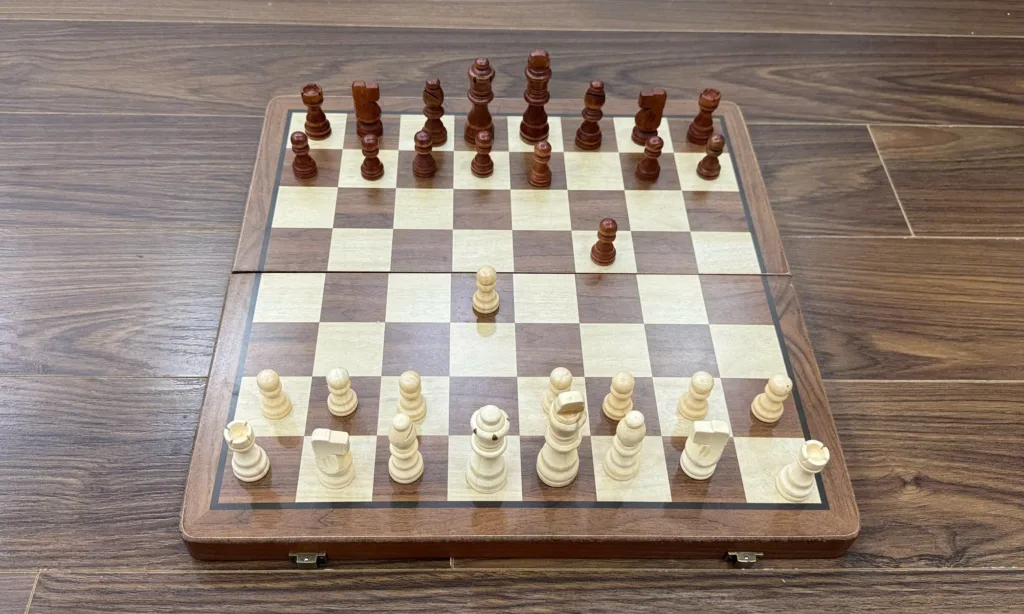Discover the Dutch Defense: a bold and unorthodox response to 1.d4 that seizes space and fights for control of the center from move one. This article breaks down all the key variations, including the Stonewall, Leningrad, Classical, and the aggressive Staunton Gambit. Packed with sharp ideas and strategic depth, it’s also my favorite opening as Black, perfect for players who want to unbalance the game right from the start.
The Dutch Defense begins with an aggressive and asymmetrical response to 1.d4:
1. d4 f5
Black immediately stakes a claim to the e4 square and signals that they’re not here to just equalize, they want a fight. This bold kingside thrust defines the Dutch Defense, one of the few major openings where Black tries to seize space on the flank early in the game.
Let’s break down the major ideas and variations of the Dutch, from the classical main lines to offbeat weapons like the Staunton Gambit.
- Main Line: Flexible Development after 2.Nf3
- Leningrad Variation: Dutch Meets King’s Indian
- Classical Variation: Solid but Sharp
- Dutch Indian Variation: A Nimzo Feel
- The 2.Nc3 Plan: Ambition from Move Two
- The Aggressive 2.Bg5 Line
- The Staunton Gambit: A Bold Strike
- A Word on White's Second Move Choices
- Conclusion
Main Line: Flexible Development after 2.Nf3
1. d4 f5
2. Nf3 Nf6
3. g3 e6
4. Bg2 d5
5. c4 c6
6. 0-0 Bd6
This structure is the Stonewall Variation, one of the most characteristic lines in the Dutch. Black locks the center with pawns on f5, e6, d5, and c6. The light-squared bishop typically comes to d6, supporting central control and kingside pressure. The downside? The c8-bishop is often hemmed in, which is why some players prefer the Leningrad setup instead. And beware: if White maneuvers correctly, the dark squares around Black’s king—especially e5 and g5—can become serious weaknesses.
Leningrad Variation: Dutch Meets King’s Indian
1. d4 f5
2. g3 Nf6
3. Bg2 g6
4. Nf3 Bg7
5. c4 0-0
6. 0-0 d6
Here, Black fianchettos both bishops and mirrors the King’s Indian Defense. The Leningrad Dutch is dynamic, aiming for a central break with …e5 or kingside activity with moves like …Qe8 and …Qh5. It’s a favorite of ambitious players who don’t mind sharp positions.
Classical Variation: Solid but Sharp
1. d4 f5
2. g3 Nf6
3. Bg2 e6
4. Nf3 Be7
5. c4 0-0
6. 0-0 d6
This line keeps the kingside flexible while maintaining central tension. Black delays committing the queenside and looks to slowly build pressure. The bishop on e7 keeps things compact, and the game can swing into either quiet positional waters or sudden tactics.
Dutch Indian Variation: A Nimzo Feel
1. d4 f5
2. c4 Nf6
3. g3 e6
4. Bg2 Bb4+
5. Bd2 Qe7
6. Nf3 0-0
With an early check and pressure on the c3-square, Black plays in the spirit of the Nimzo-Indian Defense. The idea is to provoke weaknesses or gain quick development before transitioning into a typical Dutch middlegame.
The 2.Nc3 Plan: Ambition from Move Two
1. d4 f5
2. Nc3 d5
3. Bg5 Nf6
4. Bxf6 exf6
5. e3 c6
6. Bd3 Bd6
White develops quickly and willingly gives up the bishop pair to mess with Black’s pawn structure. After …exf6, Black must balance the open e-file and doubled f-pawns with potential kingside initiative.
The Aggressive 2.Bg5 Line
1. d4 f5
2. Bg5 g6
3. h4 Bg7
4. Nc3 d5
5. e3 c6
6. Qf3 Be6
White jumps into action immediately. The early h4 signals intentions of a direct assault, while Qf3 eyes both f5 and b7. Black must tread carefully to avoid getting steamrolled before castling.
The Staunton Gambit: A Bold Strike
1. d4 f5
2. e4 fxe4
3. Nc3 Nf6
4. Bg5 Nc6
5. d5 Ne5
6. Qd4 Nf7
This is the Staunton Gambit, named after the 19th-century English master Howard Staunton. White sacrifices a pawn early to gain rapid development and attack chances. The lines are sharp and can be terrifying if Black is unprepared.
A Word on White’s Second Move Choices
After 1.d4 f5, White has several reasonable options:
- 2.Nf3 – solid and flexible.
- 2.c4 – immediately challenges the center and prepares Nc3 and g3. However, it lets Black develop with …Bb4 in some lines.
- 2.g3 – aiming for a King’s Indian Attack-style setup.
- 2.Nc3 – supports e4 and invites tactical play.
- 2.Bg5 – directly pressures the kingside and prepares aggressive pawn storms.
- 2.e4 – the Staunton Gambit, sacrificing a pawn for a lead in development and open lines.
Conclusion
The Dutch Defense isn’t for the faint of heart. Black declares war from move one, grabbing space and making no apologies for a slightly unbalanced king position or a bad bishop on c8. In exchange, Black gets active play, creative structures, and a shot at controlling the game early on.
If you’re a player who enjoys imbalanced positions, unique pawn structures, and middlegame plans full of character, the Dutch might be your new best friend.
Just be ready, White has plenty of ways to fight back.

I’m Xuan Binh, the founder of Attacking Chess, and the Deputy Head of Communications at the Vietnam Chess Federation (VCF). My chess.com and lichess rating is above 2300. Send me a challenge or message via Lichess. Follow me on Twitter (X) or Facebook.







1 thought on “Dutch Defense Secrets: Outsmart Opponents with a Side Swipe”
Comments are closed.